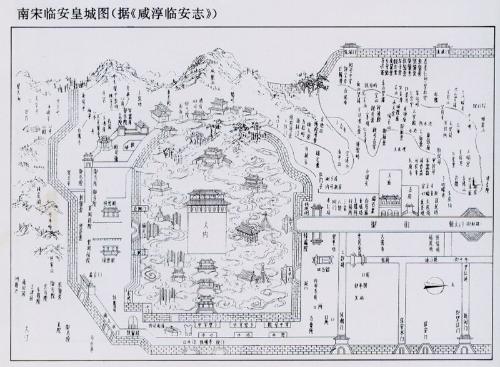Information
Underground drainage system found in the Lin’an city of the Southern Song Dynasty, Zhejiang province
Summary: In 2015, the subsurface drainage system was firstly discovered in the capital city Lin’an of the Southern Song Dynasty. Along with the discovery of the drainage system, east walls of the Lin’an city was also recovered, which renders rich information about
Discovery of the drainage system for the first time
The drainage system is comprised of surface river courses and subsurface drainage. It was important to transport the water from the Xihu Lake into the city and disperse around the city as daily activities within the city heavily relied on the water. To understand the importance of this drainage system, the excavation was conducted during April to September 2015, aiming to reveal the subsurface drainage facilities.

The aerial photo of the Southern Song Dynasty east wall remains
According to the records in texts, the niezi well was located at this spot where the ditch G1, water wells J5 and J9 were found. These features might have been associated with the niezi well. It was the first discovery of this particular type of the feature, which provides tangible evidence of the water utilization in the Lin’an city during the Southern Song Dynasty. Although the general preservation of them is not ideal, the findings do contribute to our understanding of the development of the Lin’an city during the Southern Song Dynasty and on forth.

Water diversion remains G3 of the Southern Song Dynasty
During April and June 2015, the excavation was conducted on the east wall of Lin’an city. Comparing with previous ones, this excavation covered the largest area and yielded richest remains.

Wooden tube connection of water diversion remains G1

Water diversion remains J9 and G1 (Northwest to southeast)
Application of the remote-sensing technology in detecting the city wall of Lin’an city
The modern Hangzhou city was erected upon the palimpsests of ancient cities. Therefore it would be unrealistic to excavate the archaeological remains underneath it at the cost of disturbing its modern function. The application of remote-sensing technology partially solves this problem.
Excavating the east city wall of the Yuan Dynasty
During October and December 2015, remnants of ancient city walls were discovered and the excavation was conducted afterwards. This city wall was constructed during the late Yuan Dynasty and in consistent use till its abandon in the earlier 20th century.

East wall remains of Yuan dynasty (Northeast to southwest)
This excavation area occupied an important location, in the west to which lied the east wall of the South Song city. Underneath it, there was remnant of the water enclosure of the Five Dynasties while the east wall of the Hangzhou city in the Yuan Dynasty was in the east of it. This part of the wall has the best preservation among all the walls discovered so far which clearly displays the structure of the city wall. Together with the walls of the Lin’an city found on the Shangcangqiao Road, it renders rich information on the construction technology during the Song and Yuan Dynasties in addition to the history of the Hangzhou city. (Translator: Dong Ningning)
Category: English
News
Information
Key words:

